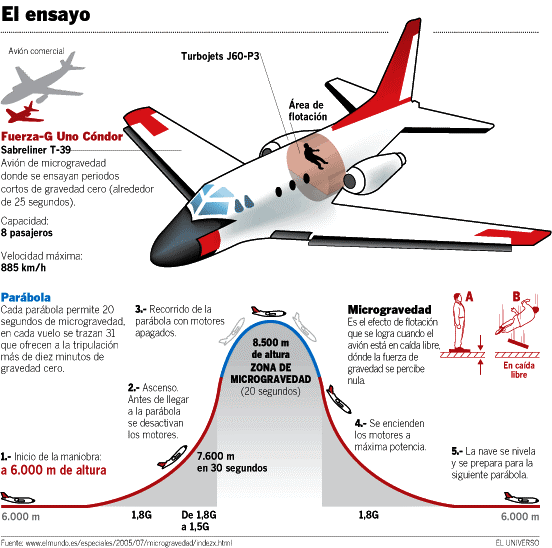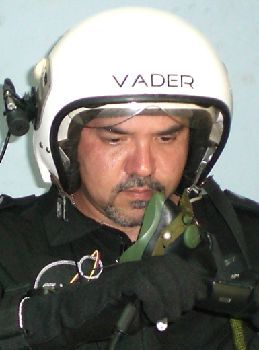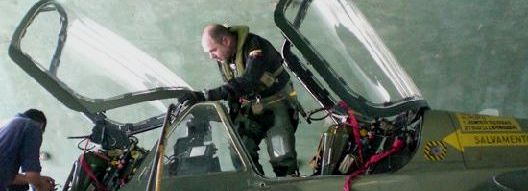|
ECUADORIAN AEROSPACE
ADVANCEMENT
Taken from El Universo, May 19 2008 |
|
|
|
Since the last May 6
Ecuador
has the first Latin American microgravity plane, such advancement
positions the
country as an aerospace development leader in the region. |
|
Ronnie Nader,
space operations director of the
EXA
(Ecuadorian
Space Agency)
explains
that this plane was the goal of the scientific project DAEDALUS, his
brainchild, and that will support the 10 year long Ecuadorian space
program. |
|
The project was made with the help of the Ecuadorian Air Force
(FAE),
and was designed to capture the microgravity flight parameters using a
device of Nader's invention, the MGCP, but before achieving this feat,
Nader did seek help from the private sector, whom didn't supported the
initiative, however, the FAE pledged its support and the project came
along. |
|
FAE
gave to
EXA
the
Sabreliner T-39
plane
(used in
the
Cenepa war),
a high performance
plane,
but it had to be
adapted to obtain the microgravity conditions.
“When we
had the plane commitment, we started to draw a plan, but we needed key
data for achieving zero G flight, y talked to my former comrades in
USA and Russia, but they couldn't help as this was very sensitive and
proprietary data", he said Facing this obstacle, Nader designed
and built the `gravimeter`, a device capable to obtain this very data
if were to be flown on a combat jet or a similar plane. HE recalls
that during the construction there was some hurdles, like that they
needed titanium, but they replaced with another material: Balsa wood,
and they could finished the device. |
The
Sabreliner T-39,
was rechristened
Fuerza-G
1
Cóndor,
and was retrofitted with a modified version of the
gravimeter
with 2 terminal screens, one before the pilots and one on the zero g
area for the mission commander.
|
|
 |
|
|
|
Laboratory
plane |
|
The plane is considered a flying laboratory where FAE pilots and
EXA astronauts can train and scientists can perform research
“We will
study all the requests for missions”,
said
Patricio Salazar,
Executive officer of the Aerospace
departament
of
FAE. |
|
He explained that the
achieved time was superior to what they were planning for, they aspire
to put this tool to the service of students of schools and
universities as well as scientist, also will help in the pre-training
of more Ecuadorian astronauts, in 2 months or less we will make great
advancements in the human microgravity flight, specially in young and
adolescent to study their physiology in order to open the doors to
this tools for them"
Nader said. |
|
|
|
Zero gravity |
|
the zero gravity state is the physical state that exists in the space
or during an space flight in orbit, here in the earth we are subjected
to gravity ONE, in the moon the gravity is 0.16 the gravity of earth
and in Mars the gravity is equal to 0.33 the gravity on earth this
means that if an object weights 100 pounds in the surface of earth, it
will weight 16 pounds on the moon and 33 pounds in Mars, but in zero G
it will weight 0 pounds and will float freely. |
|
A person in 0G feels like a free fall, very intense feeling like the
sensation of void in the stomach one would feel when traveling on a
plane while turbulence, but much more intense, for astronauts the
training conditions them so the sensation becomes pleasurable or just
vanishes, if not, the candidate has no conditions to become astronaut. |
|
|
 |
|
Profile |
|
Ronnie Nader Bello,
41
years old,
trained advanced suborbital astronaut
on the Gagarin Cosmonaut Training Center on Russia
(GCTC).
On June 8 2007 he officially became the first Ecuadorian astronaut
the completed the
(Advanced Suborbital Astronaut /Trained)
training program and the first civilian in history to achieve such
degree without belonging to any space agency. |
|
“I
rather face the impossible instead abandon a dream”
is one of his phrases. |
| |
 |
|
|
Ronnie
Nader, Ecuadorian astronaut |
Ronnie Nader on a Mirage F.1JE of FAE |
|